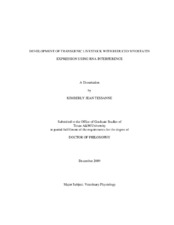| dc.contributor.advisor | Westhusin, Mark | |
| dc.creator | Tessanne, Kimberly J. | |
| dc.date.accessioned | 2012-02-14T22:17:52Z | |
| dc.date.accessioned | 2012-02-16T16:14:44Z | |
| dc.date.available | 2012-02-14T22:17:52Z | |
| dc.date.available | 2012-02-16T16:14:44Z | |
| dc.date.created | 2009-12 | |
| dc.date.issued | 2012-02-14 | |
| dc.date.submitted | December 2009 | |
| dc.identifier.uri | https://hdl.handle.net/1969.1/ETD-TAMU-2009-12-7594 | |
| dc.description.abstract | RNA interference (RNAi) is a means of regulating gene expression by targeting
mRNA in a sequence-specific manner for degradation or translational inhibition. Short
hairpin RNAs (shRNAs) and short interfering RNAs (siRNAs) have been extensively
employed for manipulating gene expression in a wide range of species. The goal for this
research was to produce transgenic livestock in which myostatin, a negative regulator of
muscle growth, has been targeted for silencing by RNAi. This would demonstrate the
utility of RNAi for reducing gene expression in large animal species. To successfully
target the myostatin gene for reduction, siRNAs were designed to target the both the
bovine and caprine myostatin mRNA sequence. These were then tested for effectiveness
in vitro using both an HEK 293T cell line expressing caprine myostatin as well as adult
bovine muscle cells. The most effective siRNA, GDF8-1026, was cloned into a lentiviral
plasmid and used to transduce bovine fetal fibroblasts for somatic cell nuclear transfer
cloning as well as perivitelline injection of in vitro produced bovine embryos. To date,
seven pregnancies have been established using these two methods.
Concern over the possibility of off-target effects associated with the expression
of shRNAs in vivo prompted investigation into tissue-specific expression. Therefore,
investigation into the use of a muscle-specific promoter to drive transgene expression
was pursued. The bovine myogenin promoter and muscle creatine kinase (MCK)
promoter were cloned into a lentiviral plasmid and evaluated in bovine fetal muscle cells
and mouse C2C12 cells in vitro for their ability to drive GFP expression. Both promoters
demonstrated an increase in GFP intensity at day nine of differentiation when compared
to the nontransduced control.
The retroviral basis of lentiviral plasmids has raised concern over the possible
development of replication competent lentivirus (RCL). Therefore, analysis of tissues
from recipients of lentivirus-treated embryos was performed to detect possible RCL.
Tissues and blood serum were tested for RCL using p24 ELISA as well as qRT-PCR for
the VSV-G gene. To date all tissues tested so far shown no evidence for RCL using these
analyses. Analysis of offspring transgenic for an shRNA targeting myostatin will allow
confirmation of RNAi as a useful tool for manipulating gene expression in large animal
species. | en |
| dc.format.mimetype | application/pdf | |
| dc.language.iso | en_US | |
| dc.subject | transgenic | en |
| dc.subject | lentivirus | en |
| dc.subject | myostatin | en |
| dc.title | Development of Transgenic Livestock with Reduced Myostatin Expression Using RNA Interference | en |
| dc.type | Thesis | en |
| thesis.degree.department | Veterinary Physiology and Pharmacology | en |
| thesis.degree.discipline | Veterinary Physiology | en |
| thesis.degree.grantor | Texas A&M University | en |
| thesis.degree.name | Doctor of Philosophy | en |
| thesis.degree.level | Doctoral | en |
| dc.contributor.committeeMember | Long, Charles | |
| dc.contributor.committeeMember | Spencer, Thomas | |
| dc.contributor.committeeMember | Ing, Nancy | |
| dc.type.genre | thesis | en |
| dc.type.material | text | en |


